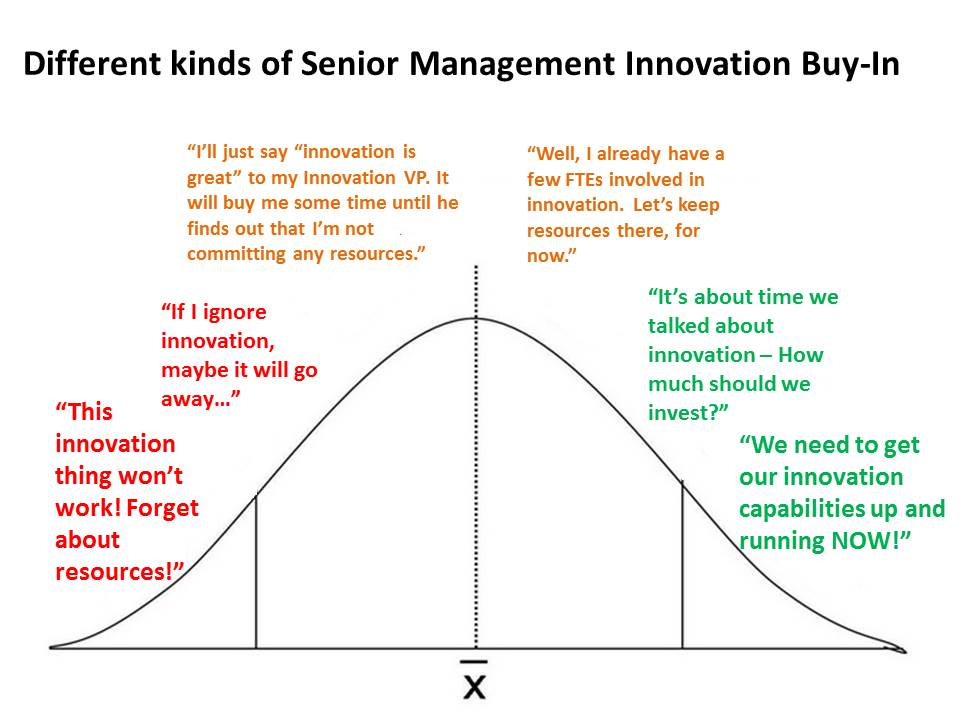Decision-makers are always happy to communicate on how much they believe in innovation. They may :
- declare how important it is that the company create a more innovation-friendly culture
- share a few corporate stories illustrating how innovation played a critical role in creating a sustainable competitive advantage, in the past
But, paying lip service to innovation doesn’t mean being committed to innovation. In fact, the real difference between a leader committed to innovation and one that isn’t is measured by the resources they are willing to allocate to innovation. Therefore, one of the most critically important question for anybody working in an innovation related role is : how do you get Senior Management to commit resources to innovation?
This is critically important:
- For Innovation and Strategy VPs, getting Senior Management to commit to innovation means getting adequate resources (in the form of additional budget or additional Full Time Employees (FTEs)), which is critical in managing and financing innovation projects.
- For Partners working in innovation and strategy consulting firms, getting Senior Management to commit to innovation means selling new projects, deepening client penetration, expanding the client base, and growing the consulting firm.
For a long time, I was wrong on who my competition was in asking for resources. I thought it was other innovation projects, or perhaps the marketing or sales departments working on product improvements. But, that turned out to be incorrect. In fact, my competition in asking for resources was operational excellence, that is the promise to lower costs, while maintaining the company’s productive output. For example, two years ago I was working for a multibillion dollar software company based in Europe, and as I was helping the innovation director get buy-in and resources from Senior Management, I realized that our most adverse competitor was CFO who was creating a purchasing department. As one might expect, the CFO was promising to reduce purchasing costs on a given segment of inputs by approximately 20%, while not changing the productive output of the company.
So, I guess the real question is: how does innovation prevail over operational excellence?
I started out by framing innovation as an opportunity. In other words, I really invested in the promise of innovation. Innovation, although incurring costs today, will secure additional revenue in the future, I though. Thus, I would calculate what those additional revenue streams would be, using market sizing, projected revenues, ROI simulations and so on. To my delight, my value propositions were often met with great enthusiasm. And I was assured that my requests for resources would be met.
But, as weeks and months went by, I would often come to the sobering realization that, in fact, resources committed to my innovation projects were lower than what I had asked and longed for. This came in stark contrast to other departments which were granted coveted resources. Obviously, framing innovation as an opportunity seemed… inopportune.
At the same time, I understood, that Senior Management Buy-In is not a question of nature but a question of degree. In other words, getting Senior Management to commit to innovation is not so much getting to a “Yes”, but, rather getting to a “Yes, with resources”. Below are different examples of Senior Management Buy-In, including:
- Divestment: “this innovation thing won’t work! Forget about resources! I’m pulling as many resources as I can!”
- Polite but uncommitting support : “I’ll just say “Innovation is great” to my Innovation VP and hopefully, he’ll go away. It will buy me some time until he finds out that I’m not committing further resources.”
- Massive investment: “We’re in danger. We need to innovate. We need to get our innovation capabilities up and running NOW!”
So I guess the real question is: how to move Senior Management from divestment or uncommitting support to real committed Buy-In, involving resources (FTEs and budget)?
Next week, I’ll share insights on how to secure buy-in from Senior Management. In the meantime, please feel free to share your experience. How were you able to get Senior Management to commit to allocating resources to innovation?
Further Readings:
- For an interesting opinion on how to sell innovation to one’s boss, please refer to this post.
- For a discussion on how to sell innovation to C-level leaders, please refer here.
- For “The Different Kinds of Senior Management Innovation Buy-In” depicted above, I’m indebted to Craig’s Bell Curve of Leader Buy-In.
- For a definition of disruptive innovation, please read this post.
- For a broader definition of innovation, please refer here.

No comment